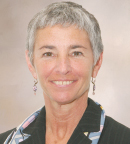It may sound too good to be true, but asking patients a simple question about what is on their bucket list can actually spark a dialogue about how best to make their cancer care and survivorship fit into their life plans, as well as be an effective way to identify their end-of-life care goals, according to VJ Periyakoil, MD, Associate Professor of Medicine at Stanford University School of Medicine and Director of the Stanford Palliative Care Education & Training Program and the Stanford Hospice & Palliative Medicine Fellowship Program. Earlier this year, Dr. Periyakoil and her colleagues published the results of their study, which explored the concept of the bucket list—an itemized list of goals an individual wants to accomplish in his or her lifetime—to identify common themes and how knowing what is on a patient’s bucket list can inform treatment decision-making.1

VJ Periyakoil, MD. ©Norbert von der Groeben/ Stanford School of Medicine.
Their study surveyed more than 3,000 individuals nationwide and found that an overwhelming majority—91.2%—had a bucket list; those who reported that religion or spirituality was important to them were most likely to have a bucket list, 95%, compared with 68.2% who said religion or spirituality was not important. The following six objectives were identified as important to the survey participants to achieve: traveling (78.5%), accomplishing a personal goal (78.3%), achieving a specific life milestone (51%), having financial security (24.3%), spending quality time with friends and family (16.7%), and performing a daring activity (15%).
“When I think of the concept of a bucket list, it’s not about waiting until you are close to death to accomplish your goals. It’s more about being aware of the fact that life is finite, time is precious, and having clear goals and plans about what we want to do in our lifetime,” said Dr. Periyakoil. For physicians, knowing their patients’ bucket lists can help them forge a personal connection and give them an immediate look into what is important to their patients, according to Dr. Periyakoil.
The ASCO Post talked with Dr. Periyakoil about how knowing what is on a patient’s bucket list can help the oncology team forge a personal connection with the patient and ensure that patients receive personalized cancer care that also facilitates fulfillment of their life’s goals.

Jamie H. Von Roenn, MD
GUEST EDITOR
Addressing the evolving needs of cancer survivors at various stages of their illness and care, Palliative Care in Oncology is guest edited by Jamie H. Von Roenn, MD. Dr. Von Roenn is ASCO’s Vice President of Education, Science, and Professional Development.Eliciting Patient Information
Did anything surprise you about the findings in your study on the concept of the bucket list?
The only thing that was surprising to me was we didn’t think about using the concept of the bucket list to elicit information about what is most important to our patients sooner. The items on the bucket lists of the respondents in our survey are the ones we hear over and over again in our practice.
Informing Patient Care
Why is it important for oncologists to ask patients about their bucket list, and how does that information inform patient care?
It is critically important for us to ask patients what is on their mind when they receive a cancer diagnosis. Knowing what they want to take on or hope to accomplish in the next year is critical information to have. For example, when healthy people decide to travel, all they have to do is get their airline ticket, book their hotel, and go. For patients with cancer, traveling presents many obstacles. These patients may have side effects, such as fatigue and nausea, from their treatment and may need periodic fluid replenishment if they become dehydrated, or opioid medication for pain. The more complicated the treatment, the more tethered they will be to their home, so their dream of traveling may need a lot of careful planning and a conversation with their physicians.
“We have no business forcing patients into a binary choice of either receiving treatment or living their lives. It’s our job to make sure patients can do both.”— VJ Periyakoil, MD
Tweet this quote
We need to use our knowledge about our patients’ illness to help them live full lives and, when possible, tailor their treatment to make sure patients can accomplish their life goals.
Forging a Personal Connection
How can oncologists use the information on a patient’s bucket list to forge a personal connection?
Our biggest loss in medicine today is the healing nature of the relationship between the patient and the physician. The doctor-patient relationship is a covenant and not a contract. Compared to the past, we now have so many tools in our toolbox to more effectively treat patients with cancer. Yet many patients are more distrustful and unhappy with doctors than ever before, and I think the reason is they don’t feel like they are being treated as unique persons with values and individuality. They perceive the care they receive as being highly technical, fragmented, and impersonal.
Knowing what’s on a patient’s bucket list for a given year offers insight into what matters most to that patient. I never ask my patients what they want to do before they die. I tell my patients what they need to know about their illness and then ask them what they have planned for the coming year. Then I see if I can adapt their care plan to ensure they receive the best possible care. Most important, I work hard to make sure my treatments don’t prevent patients from living their lives and achieving their life goals.
We have no business forcing patients into a binary choice of either receiving treatment or living their lives. It’s our job to make sure patients can do both.
Determining End-of-Life Goals
How does eliciting information about a patient’s bucket list help with end-of-life decision-making?
Once you know what is important to your patient, you can devise care that tries to meet the patient’s goals throughout survivorship, however long that may be. For example, I had a patient who wanted to be kept alive long enough to see his son graduate from high school, because he saw the graduation as a rite of passage from childhood to adulthood and that his son could then be entrusted to care for the family, so all our treatments were tailored toward trying to ensure that he could live to see his precious son graduate. He did meet this cherished life milestone and then passed away soon after.
The only caution I would offer oncologists when asking about their patients’ bucket list is to be careful how they ask the question, so patients don’t think they are obliquely telling them that death is impending and become terrified. The way I usually approach the topic is to ask patients about some life experiences they want to have and goals they want to accomplish in the next several months. I start off by giving them some examples based on what numerous other patients have told me. Then I say that I want to know what is on their list for this year to make sure I can coordinate care treatments to help facilitate and not interfere with their goals.
“Knowing my patients’ bucket list goals has prevented me from implementing medical interventions that subvert them.”— VJ Periyakoil, MD
Tweet this quote
I tell them that we hope their cancer treatment will lead to a cure and will work with them throughout their survivorship journey. I always finish by assuring my patients that our team will be with them every step of the way, come what may.
We need to remember that it’s important for all individuals to start working on their bucket list while they still can. You don’t have to be dying to start living and don’t have to wait for death to get the most out of your life.
Conversely, if a patient does have limited time, I approach the conversation by saying, “Although we are doing the best we can, we are looking at less time than we would have hoped, and time is precious, so what are the things you want to do and the experiences you want to have?” Then I plan the patient’s care around the answer.
At our institution, we started the Letter Project (http://med.stanford.edu/letter.html), in which patients can use three simple tools—What Matters Most, Who Matters Most, and I Matter Too—to help them get the most out of their lives. Our patients use the ‘What Matters Most’ template to compose a letter to their doctor about their health-care preferences; the ‘Who Matters Most’ template helps patients complete the seven tasks of life review and write a life letter to their family members; and the ‘I Matter Too’ template helps patients make a bucket list to organize the experiences they hope to have. Patients can also complete and download an advance directive from the website, which they can then send to their physicians, family members, and friends.
Knowing my patients’ bucket list goals has prevented me from implementing medical interventions that subvert them. If patients clearly make their wishes known, oncologists are likely to do everything they can to ensure treatments don’t interfere with patients living the best lives they can. ■
DISCLOSURE: Dr. Periyakoil reported no conflicts of interest.
REFERENCE
1. Periyakoil VS, Neri E, Kraemer H: Common items on a bucket list. J Palliat Med 21:652-658, 2018.

